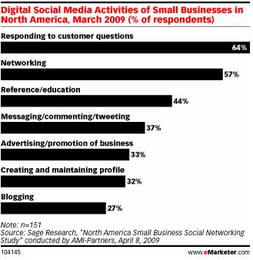Targeting Social Networks for Sales

 A recent report conducted by Sage Software and AMI-Partners shows that more than 260,000 small businesses in the US and Canada are using social networking tactics in some form or another - a surprisingly small number. Far and away, the most common uses are for customer engagement and networking. Advertising and promotion comes into play with just 33 percent of businesses. What's astonishing is that the actual selling of products didn't even enter the equation.
A recent report conducted by Sage Software and AMI-Partners shows that more than 260,000 small businesses in the US and Canada are using social networking tactics in some form or another - a surprisingly small number. Far and away, the most common uses are for customer engagement and networking. Advertising and promotion comes into play with just 33 percent of businesses. What's astonishing is that the actual selling of products didn't even enter the equation.
Perhaps one reason for this is the difficulty in calculating social media ROI. While it can be a challenge, there are ways to track purchases stemming from social networks; including custom landing pages and URLs, or special promotional codes.
When considering the incredible number of Internet users who belong to one social network or another - or several - the opportunity for direct sales is hard to pass up. Advertising opportunities abound (even behavioral and geo-targeted methods), as does the chance for product-focused campaigns to turn viral.
Below is some consolidated data from Quantcast.com. We examined five popular social websites to see where selling opportunities might exist. While a couple of these sites might not fit the social network mold, they are still highly trafficked and carry the potential for massive viral success.
| Est. U.S. Monthly Visits | Male/Female ratio | Over 18 years-old | With Kids 0-17 | Household Income $60K + | |||||
| 87.4M | 54% Female | 71% | 48% | 59% | |||||
| MySpace | 64.3M | 57% Female | 69% | 56% | 51% | ||||
| 23.0M | 55% Female | 97% | 39% | 50% | |||||
| YouTube | 81.6M | 50% Female | 78% | 43% | 54% | ||||
| Digg
|
12.4M | 37% Female | 89% | 33% | 43%
|
A few points of interest:
- Facebook is the clear leader in terms of traffic. However, it's interesting to note that households with children are on the low end. It's possible that older users (a growing Facebook demographic) are influencing the data here, as their children are likely older than other users'. That said, Facebook users appear to have the most expendable income.
- Twitter comes in fourth in expendable income and households with kids 0-17. But the user base skews much older than any of the other networks.
- YouTube skewed relatively older than expected. As the second highest trafficked site, and as online video becomes a Web standard, businesses must find opportunities here.
- Digg looks to be one of those niche social sites that could be a boon to some, but worthless to others. It scales overwhelmingly single male with low income. However, it has big viral potential and is popular with the tech-savvy crowd.
Without question, social networks present sales opportunities for small business. But to be successful, businesses need to track their efforts through analytics and by setting specific goals. Use special promotions and targeted advertising. It's also a good idea to test the waters of the various networks before committing to one or the other. Finally, transparency is key. Social networkers will not object to a targeted, valuable sales pitch, as long as they don't feel they are being duped. Be clear about your objective - everyone loves a good deal, they just don't want the runaround.

Subscribe to Our Newsletter!
Latest in Social Media










